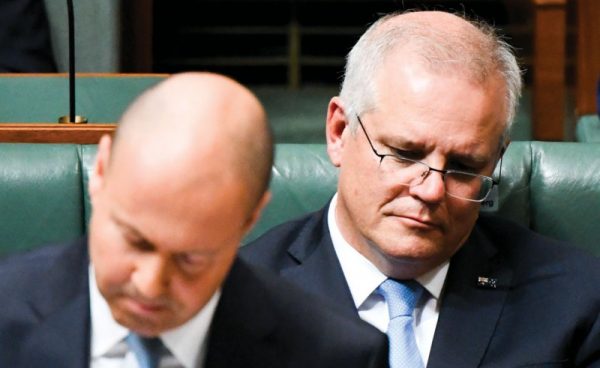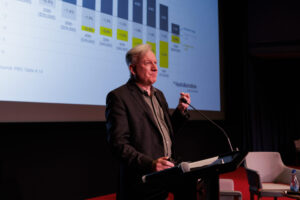The budget shows that the government is not interested in lifting women out of poverty

Josh Frydenberg and Scott Morrison don’t care about lifting a million Australian women out of poverty, and their budget proves it. There was no increase in unemployment benefits or rent assistance, or policy to boost the wages of the lowest paid workers, most of whom are women. Even the new childcare subsidies they announced don’t kick in until July next year, most likely after the next election.
The words in budget speeches may reveal a government’s political priorities but it’s the dollars in the budget papers that reveal its real priorities. And while this year’s budget speech mentioned the word “women” 15 times, as many times as the last seven Coalition budgets combined, the treasurer made no mention of any policies to close the gender gap in wages, retirement incomes or homelessness.
While Frydenberg’s speech referred to Australians pulling together, his policy priorities will drive them further apart.
Victim-blaming lies at the heart of Australian politics, so it should come as no surprise that it is at the centre of the government’s budget and economic policies. Indeed, the opening sentence of the Women’s Budget Statement tells us that, “For Australia to succeed, Australian women need the freedom and opportunities to make genuine choices about their career and their future …” Enormous tax cuts for those on the highest incomes, we are told, will provide us all with more incentive to work harder and make better choices. And if women would only stop “choosing” low-paid jobs in childcare, aged care and retail, then they could fix the gender pay gap themselves.
But is the problem that women choose to work in aged care or to have kids, or that the government chooses to suppress wages and provide expensive childcare? Is it women choosing to have children, and to stay home and care for them, that delivers them lower superannuation balances than men, or the government choosing to spend more on tax concessions for men’s superannuation than women’s? What does it mean for Australian women to make a “genuine choice” between whether they should work for low wages and pay expensive childcare fees, or look after their own kids and retire in poverty?
The structural inequalities in the Australian economy didn’t just happen. They aren’t the result of poor choices by women in the workforce. And they aren’t found in all rich countries. Importantly, it also wouldn’t be hard to fix these problems, if we wanted to.
It took more than a century to build an Australian labour market where it’s normal for women to earn significantly less than men, for expensive childcare to discourage large numbers of women from working after they have kids, and for a lot more women to retire in poverty than men. And while Australia is finally coming to terms with the fact that it’s not normal for so many women to be assaulted by men, we still think it’s normal that the majority of women who are employed as casuals have no paid sick leave or holiday pay, which means if they need to recover from a physical or sexual assault, they can do it at their own expense. It’s not as if the government is unaware of this horror. Labor and the Greens both proposed to legislate domestic violence leave for all workers prior to the 2016 election, a call that was rejected by the Australian Chamber of Commerce and Industry and by the Coalition, which, in true neoliberal style, proposed instead for women to self-fund domestic violence leave via early access to their superannuation.
Australia is one of the richest countries in the world and, in the past 12 months, the government has spent an extra $200 billion on everything from subsidised airfreight for lobsters to $22 million to boost Harvey Norman’s profits, even though retail sales were booming. We can afford to help whomever we want, and the budget makes clear the government doesn’t, for example, want to eradicate homelessness among older women. The new “women’s spending” announced in the budget was the equivalent of providing handwarmers to the homeless.
Fixing the structural causes of gendered poverty and the violence it enables isn’t on the cards in Australia – it’s not even on the horizon. The gender pay gap didn’t get a mention in the budget speech. To be fair, the treasurer did note that women “retire with less superannuation than men”, but he didn’t mention it is a staggering 42 per cent less. This enormous gap should be no surprise; it’s the inevitable consequence of basing a retirement income system on your lifetime earnings when you know women get paid less than men, and take more time out of paid work than men to care for others. Everyone at Treasury knows that, so hopefully the treasurer knows that too. But knowing doesn’t mean caring.
In the Nordic countries, where childcare is free or very low-cost, a much higher proportion of women re-enter the workforce in the years after they give birth than in Australia. Whether they realise it or not, when Australian women make their “genuine choice” to work in the low-paid care sector, to work as a casual, or to take a few years from paid work to care for their kids, they are apparently choosing to make much smaller contributions to their superannuation account than men who work full-time in higher paying jobs. Likewise, whether they realise it or not, when Australian women choose to make much smaller contributions to their superannuation than men, they are also choosing to receive far less support from taxpayers for their retirement nest egg. Few people realise how perverse the Australian retirement income system is: because it’s based on the principle that the more you put in, the more the government puts in, the vast majority of tax concessions for superannuation flow to high-income earners (most of whom are men) and virtually none of them flow to low-income earners (most of whom are women).
This year, the federal government will spend around $41 billion on tax concessions for superannuation to help us all “be more secure once in retirement”, as the treasurer put it. But as with physical security, men get a lot more financial security in retirement than women. According to modelling by The Australia Institute, the top 20 per cent of income earners receive around $21 billion in tax concessions from super, while the bottom 20 per cent receive only $750 million. Men receive more than 70 per cent of the tax concessions for superannuation, while women receive just 30 per cent.
While it is true, as the treasurer announced on budget night, that employers will now have to make superannuation contributions for the 300,000 people who earn less than $450 per month, and it’s true that 63 per cent of those people are women, it’s also true that this measure will make little difference to the 42 per cent less super earned on average by women.
It gets worse. Women are often encouraged to make “voluntary contributions” to their super to help them close the gap with men, but this is about as helpful as encouraging low-income earners who can’t afford to buy a house to save a little harder. Unsurprisingly, men are far more likely to make large voluntary contributions to their superannuation for the simple reason that they have much higher disposable incomes. Which brings me to the government’s next round of tax cuts.
The so-called Stage 3 income tax cuts will deliver up to $9050 more per year for those earning more than $200,000. Around $12 billion of the $18 billion per year cost of these tax cuts will flow to men, which inevitably exacerbates superannuation inequality.
The Morrison government isn’t trying to fix the gender pay gap, or the retirement income gap. It’s trying to fix the perception that it’s a cabinet full of blokes who otherwise shower public praise and cash on the blokes in high-vis and hard hats. While its spokespeople were at pains to talk up the government’s “women’s budget” for the ABC and breakfast-TV audience, the front page of the tabloids assured tradies that tax breaks for their utes would be extended. The cost of the “instant asset write-off” was $17.9 billion over forward estimates, while the Office for Women had its budget slashed by $7.1 million.
The prime minster wrote a foreword for the Women’s Budget Statement in which he declared, “The gender pay gap is also at a record low of 13.4 per cent, well down from the 17.4 per cent we inherited when we came to office in 2013.” While he is never one to miss the opportunity to brag, it seems that neither he nor his office are given to checking their facts too closely. The source of the 13.4 per cent figure, the government’s own Workplace Gender Equality Agency, cautioned that it was affected by the impact of COVID-19 on the labour market and changes to the way that the Australian Bureau of Statistics was reporting data. Hence the WGEA made clear that it would “not compare this year’s gender pay gap statistics to previous years”. The PM had no such hesitation.
But just as Morrison is betting that tradies won’t read the stories about his “focus on women” in Guardian Australia and that the women reading those stories will miss the front page of The Daily Telegraph, the PM is betting that few people will read his foreword in the Women’s Budget Statement and that even fewer will read the qualifications to the data his bragging relies upon.
Divide and conquer is the oldest of strategies, which is why the Morrison government has no desire to close the gaps that define Australia. On the contrary, it wants to exploit them by offering tidbits to those most in need, and a feast to those with the most swinging votes. If it plays its cards right, it will be rewarded by both groups.
Between the Lines Newsletter
The biggest stories and the best analysis from the team at the Australia Institute, delivered to your inbox every fortnight.
You might also like
Victoria’s Electoral Laws Need Truth in Advertising and Fair Rules for New Entrants
Victoria should adopt truth in political advertising and address the unfairness created by its donation cap and public funding model.
On International Women’s Day: How the Fair Work Commission Can Really Take On the Gender Pay Gap
On occasion of International Women’s Day, the Centre for Future Work’s Senior Researcher Lisa Heap reviews the opportunities to use recent industrial relations reforms to more ambitiously address Australia’s gender pay gap.
Stage 3 Better – Revenue Summit 2023
Presented to the Australia Institute’s Revenue Summit 2023, Greg Jericho’s address, “Stage 3 Better” outlines an exciting opportunity for the government to gain electoral ground and deliver better, fairer tax cuts for more Australians.


